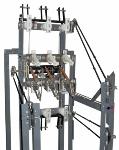Repair of load break switches
 Repair load break switches carried out together with the repair of the rest of the substation equipment within the terms set by the construction nomenclature. When repairing load switches, they clean all parts of the switch from dust, dirt, old grease and rust, check the verticality and reliability of the switch frame, carefully examine the insulators and plastic arcs of the rescue chambers to establish their integrity. If there are cracks, they are replaced.
Repair load break switches carried out together with the repair of the rest of the substation equipment within the terms set by the construction nomenclature. When repairing load switches, they clean all parts of the switch from dust, dirt, old grease and rust, check the verticality and reliability of the switch frame, carefully examine the insulators and plastic arcs of the rescue chambers to establish their integrity. If there are cracks, they are replaced.
The arc chambers of the load-break switches are disassembled, cleaned of soot and their Plexiglas linings are inspected. If the thickness of the lining walls is less than 1 mm, they are replaced. They control the attachment of the isolators to the frame and the contact devices of the isolators.
Then the condition of the movable and fixed, main and arcing contacts is checked: the distortion of the movable arcing contacts is eliminated, a slight burn is applied with a file, and in case of a strong burn, the contacts are replaced.
By slowly closing the switch, make sure that the axes of the movable and fixed main contacts coincide and that the movable arc contacts can freely enter the throat of the arc chambers. When the switch shaft is turned 70°, the blades should move 50° and the arc extinguishing sliding contacts should enter the chamber by 160 mm.
If switching on the switch ends with knives biting the edges of the fixed contact, it is necessary to eliminate this by changing the length of the rod connecting the shaft of the switch to the drive.
If the switch is very difficult to close, the rubbing parts should be cleaned and lubricated, and the correct connection between the switch and the actuator should be checked.
After that, the clarity of the blocking and the condition of the flexible connection connecting the shafts of the switch-disconnector are checked. The last part of the repair is touching up the frame, levers and rods, as well as lubricating the contact surfaces with a thin layer of technical petroleum jelly.
